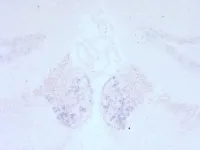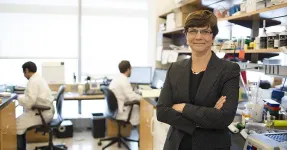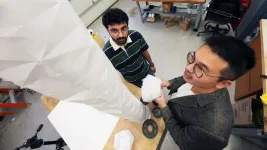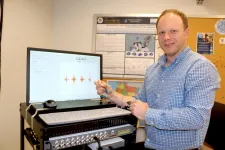(Press-News.org) Measuring airborne grass allergen levels instead of pollen counts will be more beneficial for hay fever sufferers as new research shows grass allergen levels are more consistently associated with hay fever symptoms than grass pollen counts.
The research, published today in The Journal of Allergy and Clinical Immunology and led by King’s College London and Imperial College London, shows for the first time that measuring airborne allergen levels will help people with hay fever better control their symptoms.
1 in 4 adults in the UK suffer from hay fever from late-March to September. Symptoms include a runny or blocked nose, sneezing and coughing and itchy, red or watery eyes. Hay fever can make lung conditions such as asthma worse, causing wheezing and breathing difficulties which can lead to hospitalisation.
Many people with hay fever monitor peak pollen times to manage their symptoms. In the UK, pollen grains are manually measured to find the daily pollen count. But authors of this study say measuring allergen levels instead will be more accurate as each pollen grain can release a different amount of allergen each day, and it is the allergens in the air that are primarily responsible for causing hay fever symptoms. Currently, there is no regular monitoring of allergen levels in the UK or elsewhere.
Authors collected daily symptom and medication scores from adult participants in an allergy clinical trial as well as daily counts of asthma hospital admissions in London. They measured grass pollen counts and but also sampled air for the grass pollen Phl p 5 grass allergen protein in the same location at King’s College London over the same time period.
First author Dr. Elaine Fuertes, from Imperial College London, said: “Grass pollen is the most common hay fever trigger. In this study, we measured grass allergen (Phl p 5) levels and found this was more consistently associated with allergic respiratory symptoms than grass pollen counts.”
Senior author Professor Stephen Till, from King’s College London, said: “High pollen season can be serious for people who suffer with hay fever, and can trigger severe asthma attacks in those who are allergic to grass pollen. This study shows there is a superior way of measuring pollen allergens in the air than the traditional pollen count. Monitoring grass allergen instead of grass pollen counts gives results that are more consistently linked to patients’ symptoms and could allow people with serious allergies to be better prepared during the pollen season.”
Research is ongoing to see whether regular measurement of allergen levels can become the standard in the UK, and whether there are other environmental factors, such as meteorological factors including temperature, wind, humidity, and air pollutants, that influence how much allergen each pollen grain releases.
Read the paper Phl p 5 levels more strongly associated than grass pollen counts with allergic respiratory health in The Journal of Allergy and Clinical Immunology by authors from King’s College London, Imperial College London, Technische Universität München and Helmholtz Center Munich, Germany, University of Florence, and USL Toscana Centro, Italy.
END
Measuring grass pollen allergens instead of grass pollen count will help hay fever sufferers
2024-01-09
ELSE PRESS RELEASES FROM THIS DATE:
Clear link between autoimmune disease and perinatal depression
2024-01-09
Women with autoimmune disease are more likely to suffer from depression during pregnancy and after childbirth; conversely, women with a history of perinatal depression are at higher risk of developing autoimmune disease, a new study from Karolinska Institutet published in the journal Molecular Psychiatry reports.
In autoimmune disease, the immune system mistakenly attacks the body’s own healthy tissue. Some of the most common autoimmune diseases are gluten intolerance (coeliac disease), autoimmune thyroiditis, rheumatoid ...
Diagnostic errors are common in seriously ill hospitalized adults
2024-01-09
A study of seriously ill patients from academic medical centers across the country has found that nearly a quarter had a delayed or missed diagnosis.
All the patients had either been transferred to the intensive care unit (ICU) after being admitted or died in the hospital. The researchers concluded that three-quarters of these diagnostic errors contributed to temporary or permanent harm, and that diagnostic errors played a role in about one in 15 of the deaths.
The most common errors identified in the study involved delayed rather than missed diagnoses, for example because a specialist was consulted too late or an alternate diagnosis was not considered ...
Scripps Research scientists give new insight into a molecular target of alcohol
2024-01-09
LA JOLLA, CA— Ethanol—the compound found in alcoholic beverages—interferes with the normal functioning of a long list of biological molecules, but how each of these interactions contributes to the behavioral effects of alcohol is not fully understood. A guiding, but elusive, goal of researchers is to identify the protein (or proteins) to which ethanol binds that makes some people vulnerable to excessive drinking. Solving this question would point the way to effective therapies for alcohol use disorder, ...
Coastal populations set to age sharply in the face of climate migration, FSU researcher finds
2024-01-09
As climate change fuels sea level rise, younger people will migrate inland, leaving aging coastal populations — and a host of consequences — in their wake, a study by Florida State University researchers finds.
While destination cities will work to sustainably accommodate swelling populations, aging coastal communities will confront stark new challenges, including an outflow of vital human infrastructure such as health care workers, said Associate Professor of Sociology Matt Hauer, lead author of the study published in the Proceedings of the National Academy of ...
World-renowned surgeon named new director of Moores Cancer Center at UC San Diego Health
2024-01-09
Following an extensive national search, Diane M. Simeone, MD, has been appointed director of Moores Cancer Center at UC San Diego Health, effective April 1, 2024.
Simeone brings robust institutional, national and international leadership experience to both oncologic patient care and scientific research, with a focus on establishing novel models of interdisciplinary collaboration. She is an internationally recognized surgeon-expert in the biology and multidisciplinary treatment of pancreatic neoplasms, with an active clinical practice in pancreatic surgery.
Simeone currently serves as the Laura and Isaac Perlmutter ...
Origami-inspired robotic plants grow with their environment
2024-01-08
How do you deploy an environmental sensor to collect climate change readings over a prolonged period on an uninhabited island without failing? How do you power a seismic detector to operate for months in an underwater cave?
In environments that are difficult to reach because of the hazards or hardships for humans, a device behaving like a native plant could be the answer. This is the approach taken by Suyi Li, associate professor in mechanical engineering at Virginia Tech, and Clemson professor and collaborator Ian Walker. Their work is being advanced ...
New research identifies high rates and common causes of diagnostic errors in hospitals across the nation
2024-01-08
Almost a quarter of patients who were admitted to the ICU or died in 29 hospitals in the United States experienced a diagnostic error
Efforts and initiatives are underway across the country to address and prevent the causes of diagnostic errors
A new study from researchers from Brigham and Women’s Hospital, a founding member of the Mass General Brigham healthcare system, in collaboration with researchers at the University of California San Francisco, has shed light on the rate and impact of diagnostic errors in hospital settings. In an analysis of electronic health records from 29 hospitals across the country of 2,428 patients who ...
Final supernova results from Dark Energy Survey offer unique insights into the expansion of the universe
2024-01-08
In 1998, astrophysicists discovered that the universe is expanding at an accelerating rate, attributed to a mysterious entity called dark energy that makes up about 70% of our universe. While foreshadowed by earlier measurements, the discovery was somewhat of a surprise; at the time, astrophysicists agreed that the universe’s expansion should be slowing down because of gravity.
This revolutionary discovery, which astrophysicists achieved with observations of specific kinds of exploding stars, called type Ia (read “type one-A”) ...
Life span increases in mice when specific brain cells are activated
2024-01-08
In recent years, research has begun to reveal that the lines of communication between the body’s organs are key regulators of aging. When these lines are open, the body’s organs and systems work well together. But with age, communication lines deteriorate, and organs don’t get the molecular and electrical messages they need to function properly.
A new study from Washington University School of Medicine in St. Louis identifies, in mice, a critical communication pathway connecting the brain and the body’s fat tissue in a feedback loop ...
Robotic rehab aims to help stroke patients regain hand dexterity
2024-01-08
Every year, about 800,000 new stroke cases are reported in the United States, often causing patients problems with both neurological and physical motor control. Disruptions in the mobility of the arms and hands, in particular, can have devastating impacts on stroke patients’ quality of life.
The restoration of arm extremity and hand dexterity are often the highest priority among stroke patients. A new robotic platform developed at the University of Rhode Island, which utilizes both a patient’s brainwaves and muscle activity, aims to help post-stroke patients perform needed rehabilitation and regain critical motor skills, including complex tasks like reaching and grasping ...





